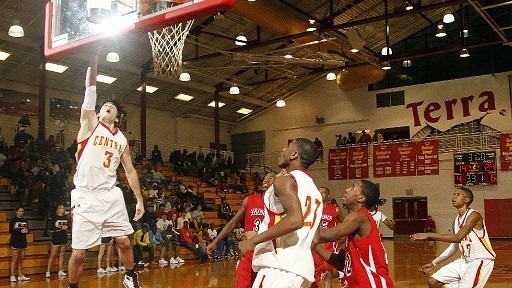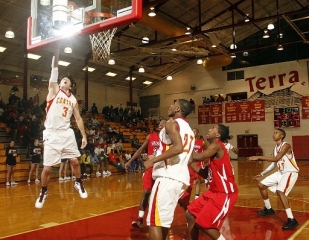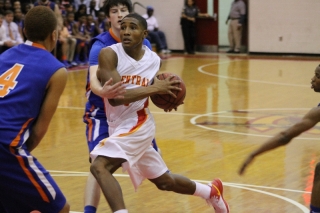By CHAD RHYM – Sports Writer
With AARON HOLMES – Junior Copy Editor
Before the National Basketball Association’s integration in 1950, the sport was Whites-only. However, in subsequent decades, the number of African American and foreign players has increased to more than 90 percent of all NBA athletes. In the Clarke County School District’s two traditional high schools, the percentages are even more slanted.
According to a piece on ESPN’s Outside the Lines, an Emmy Award-winning investigative series, aired in Dec. 2009, the percentage of African American basketball players in the National Basketball League is 71.8, internationals account for 18.3 percent, and the percentage of White Americans is 9.9.
2010 CCHS graduate Taylor Layne aggressively drives to the basket and finishes with a right-handed layup against Winder-Barrow High School on Feb. 2, 2010 at CCHS. Layne was the only White American on the 2010 CCHS basketball team. He was named the team’s Co-MVP his senior season alongside teammate Babatunde Olumuyiwa. Photo Courtesy of Richard Hamm.
In the last five NBA drafts, 195 African American, 80 international and 25 White American players were selected.
This racial disparity holds true within male basketball teams in the Clarke County School District’s two traditional high schools. Clarke Central High School has one White American player within its program: ninth-grader Ellis Flurry, who plays on the freshmen team. Cedar Shoals High School has four White American male players — ninth graders Jack Schramski and John Flexner, both guards for the freshmen team, sophomore Garrison Hefner, a junior varsity forward and senior Sam Flexner, a varsity forward.
“It seems like in Georgia, (and) the Clarke County School District, basketball is dominated by African Americans,” Sam said. “White people in general might play when they’re younger, but not continue to get better and so they stop playing.”
Currently, Sam is the first White American player in the CCSD’s varsity basketball program since 2010. Before Sam, the most recent White American varsity player in CCSD was Taylor Layne, who was a varsity forward for CCHS from 2007-10.
According to Layne, White American players may have been intimidated and therefore discouraged to play.
“Maybe (White players) feel they are inferior to African Americans, or maybe they are not willing to put in the time and effort,” Layne said. “They don’t want to try out because they’re afraid they’re just going to ride the bench.”
However, Layne personally feels that there is no race-defined boundary regarding a given player’s skill.
“I feel that I can play just as well as them if I put in the time and effort, so I don’t think that (race) has anything to do with it,” Layne said.
Lee Brackman is a sophomore guard on the varsity basketball team at Monsignor Donovan Catholic High School, a majority White American populated private school located in Athens. Like Layne, Brackman believes intimidation may prevent some White Americans from participating in basketball.
“I think that, in general, White people are scared of Black people. I don’t want to be blunt, but the stereotype is that Black people are better than you (at sports), and they jump higher than you and can run faster than you,” Brackman said. “That might be true in some players, but people are just sometimes too scared to give it a try.”
However, Stefan Smith, CCHS head JV coach, says a player’s skill set is not determined simply by the color of their skin.
“I’ve seen White kids who could jump just as high or higher than African Americans and I’ve seen African Americans just not be able to jump,” Smith said. “I’m a guy who couldn’t jump high (and) I’m African American, (but) that’s what the media portrays it as. I think some White kids can jump. We had a kid a few years ago that could jump, Taylor Layne.”
Former CCHS point guard and 2001 graduate Stan Lanier believes there is a range of causes for the lack of diversity. According to Lanier, a White American, economic stability may be a deciding factor for participation in particular sports.
“I would assume that the poorer population of inner cities chooses to play basketball because it’s a cheaper sport to play,” Lanier said. “Baseball is generally pretty expensive to play because of all the equipment costs. With basketball, you just need shoes and a basketball.”
Joey Gawrysiak, an assistant professor of sports management at the University of Georgia, graduated from UGA in 2012. Gawrysiak completed his dissertation on the underrepresentation of African American athletes in baseball, and currently teaches sports sociology classes at UGA. He believes that while economic issues are present, they may not be a deciding factor.
CCHS junior guard Jaquan Dowdy beats CSHS senior forward Sam Flexner off the dribble in a rivalry game between the Gladiators and the Jaguars at CCHS on Jan. 19. Dowdy racked up 15 points and Flexner contributed with seven in CCHS’s win against CSHS with a final score of 78-59.
“Economic factors are not as impactful as people might want them to be. I know economics certainly is a factor in sports participation patterns, but I don’t see it as near as impactful as socialization or cultural factors,” Gawrysiak said. “I think certainly that basketball is a sport that you can play more easily without a lot of money, its an easy concept, not a lot of equipment compared to sports like baseball and hockey that require a lot of money. Basketball is a cheaper sport which means more people can play.”
While economic factors may be a reason behind the divide, Gawrysiak also believes that basketball is a big part of African American culture in general.
“When we talk about cultural expectations and values, basketball allows the freedom to excel athletically and run and jump higher. Basketball has so much more self expression in it. It’s cool in the African American community to play basketball,” Gawrysiak said.
Brackman believes there are significant cultural differences between White and Black players that affect their skills and team interactions.
“Black high school players have their own way of communicating with each other. African Americans, from a young age, learn to play quick styles, where as White people do more shooting and less conditioning,” Brackman said. “You could make a statement that there is a ‘White and Black’ style of basketball.”
However, UGA assistant basketball coach Phillip Pearson, who previously coached at Murray State University, rejects the concept of differing “styles” based on race.
“It’s just basketball to me: white, green or yellow. I’ve been coaching for a long time. I’ve played with African Americans, coached with Caucasians and African Americans and had an African American coach in high school,” Pearson said. “Basketball has changed over the years, yes. But it’s just basketball.”
In addition to cultural factors that lead African Americans to participate in basketball, Pearson, who is White American and a former University of Alabama basketball player from 1989 to 1994, says peer relations impact participation in particular sports.
“There might be a certain environment that leads a player out of one sport and into another, like a certain group of friends,” Pearson said. “There is some correlation to (race). At times, the Caucasian players end up going a different route to a different sport, like baseball.”
Junior Jaquan Dowdy, a guard on the varsity basketball team, agrees. Dowdy has not once played alongside a White American in his three years as a part of the CCHS varsity basketball team.
“White Americans are starting to play different sports like baseball, soccer or something else because they’re taking over those sports, while African Americans are taking over basketball,” Dowdy said.
Layne played varsity basketball for CCHS the entirety of his high school years, yet he says his position as a minority did not discourage him from participating.
“I feel that it was a good thing to go through that a lot of people don’t get to (experience),” Layne said. “The guys on the team were my friends and we had nothing against each other, it didn’t bother me at all. We were all one team. Race never had anything to do with it. We were always just like brothers.”
A more literal kind of brotherhood provided inspiration for CCHS senior Kevin Erickson, who played basketball as a freshman, when Layne was a senior on the team. Erickson’s two older brothers, class of 2006 graduate J.B. Erickson and class of 2010 graduate Adam Erickson, played basketball while in high school. Kevin was a junior varsity point guard before quitting after his sophomore year.
“(I had) a good start my freshmen year, but it just started to get stressful,” Erickson said. “There was a lot of criticism that I wasn’t used to.”
Erickson believes that criticism, as well as a lack of role models discourage White American males from playing at the high school level.
“It correlates because white people are in the NBA less,” Erickson said. “There aren’t a lot of white people being inspired at a young age.”
Brackman agrees that there are a lack of role models for young White American players looking for inspiration.
“Me, a young white kid, I can relate to no one in the NBA, because I’m not 6’4″ or 6’5. I can relate to two point guards in the NBA, Gorgan Dragic (a Slovenian) and Steve Nash (a Canadian), and they’re not even White Americans,” Brackman said. “While if I was a young African American, I could easily say I want to be like Rajon Rondo, I want to be like Russell Westbrook, I want to be like Derrick Rose. We try to shape our basketball lives off of someone else’s and there are just less people for White Americans to be able to do that.”
Despite an absence of role models within the NBA, Lanier found inspiration to play basketball through his own competitive desire.
“Most people I was close friends with played baseball. I got into basketball when I was 10 or 11 years old, but very few of my friends played basketball,” Lanier said. “The things that inspired me to play from a young age were my competitive nature and my hand-eye coordination.”
Upon joining the CCHS team, Lanier found a level of comfort based on his skill set and ability to socialize with teammates.
“They had no problem with me. I was comfortable on the team,” Lanier said. “I was widely accepted.”
The majority of Lanier’s interactions with coaches and players were positive, however, he was the victim of varying degrees of teasing while in the program.
“I remember certain references by a coach or by players, ‘You’re not expected to be able to dunk a basketball because you’re white.’ It was a reference I heard many times. Teammates and coaches kind of ridiculed me,” Lanier said.
At times, according to Lanier, angered members of opposing teams would revert to racial name-calling towards him.
“There were a couple of racial slurs from a basketball coach here and there,” Lanier said.
The expectation, according to Lanier, was that his game was one dimensional: he could shoot.
“I remember Coach (Billy) Wade called me ‘The Shooter,’” Lanier said. “They (teammates) even called me that sometimes as a nickname.”
Twelve years after Lanier’s graduation from high school, there is much less racial tension surrounding the participation of a white player on the basketball team, according to Sam.
“I’ve been with the guys so long, I don’t notice it,” Sam said. “Do I care that I’m the only White boy? No, I don’t. I don’t even realize it.”
While Sam admits that his race might remain a talking point for those of an older generation, he says he and his teammates do not recognize it as such.
“Other people definitely see it. I guess to parents it’s easy to pick me out, but as an experience, it just feels like a team,” Sam said.
[pullquote]”…race never had anything to do with it. We were always just like brothers.”
-Taylor Lane, former CCHS basketball player[/pullquote]
However, Sam acknowledges that his positive relationship with African American team members does not necessarily transfer off the court.
“The kids that have known each other and hang out outside of school are closer than I am to them. I would say that I don’t really know them outside of basketball,” Sam said.
Like Sam, Lanier says the lack of off-court interaction is a degree of de facto segregation.
“When I went to Clarke Central, it had been integrated for some 30 years, but there were a lot of aspects of the school that I still thought were segregated,” Lanier said. “For instance, the lunchroom didn’t have signs that said, ‘Whites sit here’ or ‘Blacks sit here,’ but that’s the way the lunchroom broke down.”
In Lanier’s experience, these principles of self-segregation apply to the realm of high school athletics.
“It was the same sort of thing when it came to basketball. I remember when I was playing, people would say, ‘Wait, you’re on the basketball team? I didn’t think any White people who played on the basketball team,’” Lanier said. “It was an unwritten rule: the basketball team is for Black players only.”
Gawrysiak believes that the number of White American basketball players will continue to dwindle in the future.
“I think the number will only continue to get worse. I do think a lot of White Americans will play in high school but after that a lot of white kids don’t see that as a chance for social mobility to go on and have a professional career,” Gawrysiak said. “But in the African American community a lot of times the sport of basketball is seen as a social mobility, it’s like a way to go to school or even have a pro career. So I only think that the participation of White Americans will get worse as time goes on.
However, Flurry completed his first year on the CCHS freshmen team as its sole white player, and he resolves to continue playing. Flurry is also unhindered by his unique status.
“I don’t mind being the only White player. The sport is the same; it’s still just as rewarding,” Flurry said. “Of course (I’ll keep playing), I enjoy being on the team, and I have no reason to stop.”



